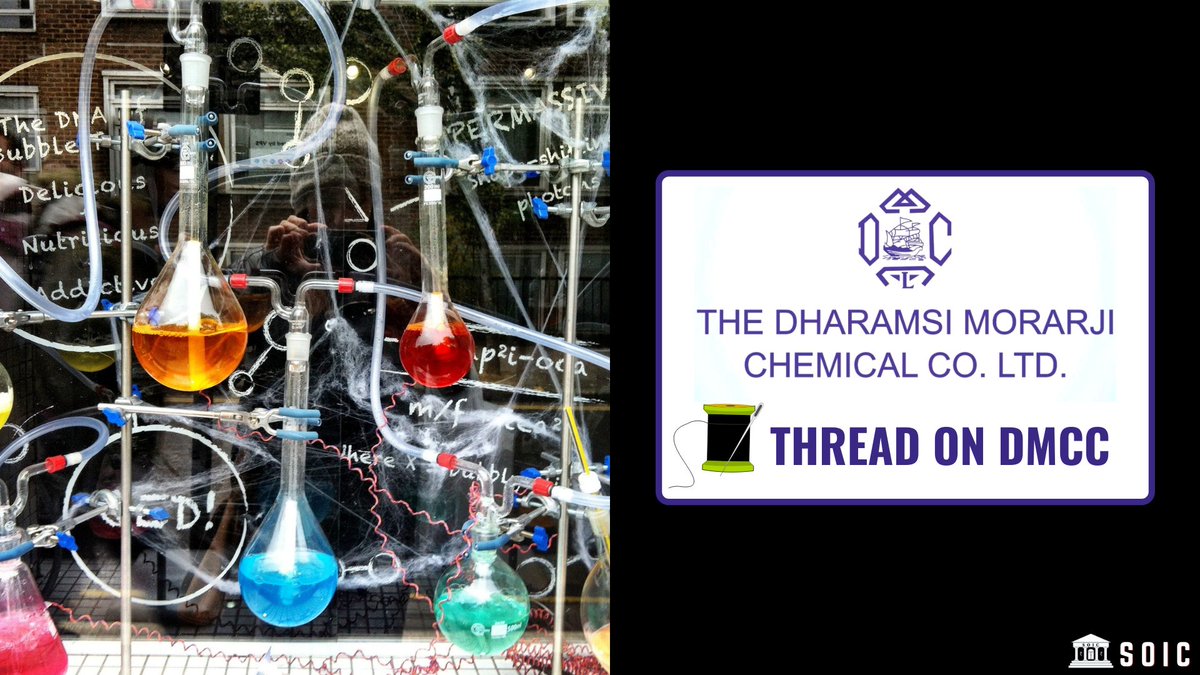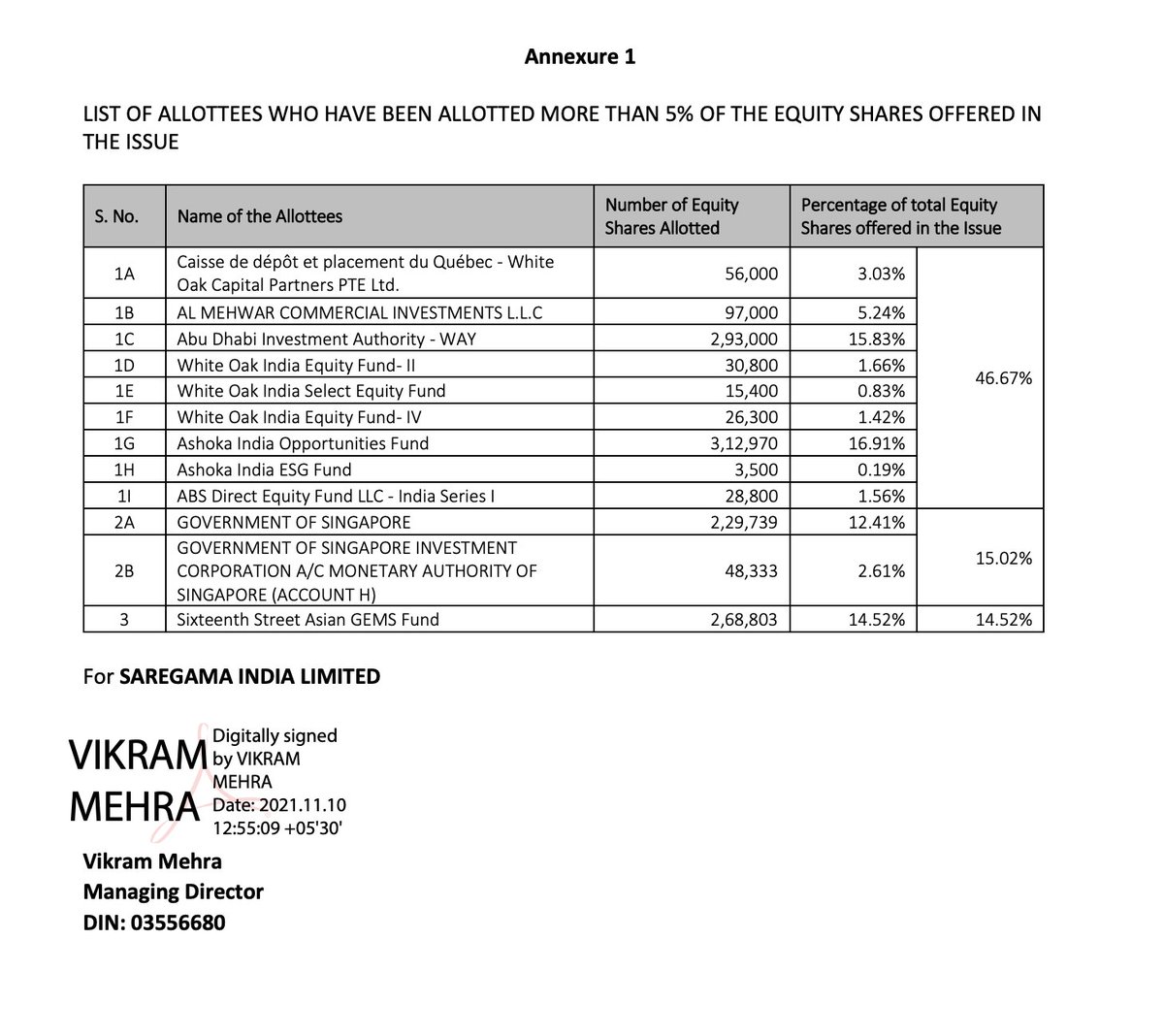
Dharamsi Morarji Chemical Co Ltd. (DMCC)
#DHARAMSI
Annual Report 2021 Threaded 🧵🧵🧵
RETWEET FOR MAX REACH
Let's put the thread into 5 beads: 🪡📿
1. Company
2. Industry
3. Strategy
4. Management
5. Risks
#DHARAMSI
Annual Report 2021 Threaded 🧵🧵🧵
RETWEET FOR MAX REACH
Let's put the thread into 5 beads: 🪡📿
1. Company
2. Industry
3. Strategy
4. Management
5. Risks

First, let’s look at a very relevant framework of a seasoned investor,
Mr Vijay Kedia (@VijayKedia1) & his SMILE 😊
SMILE: Small in size, Medium in experience, Large in aspiration & Extra-large in market potential.
Mr Vijay Kedia (@VijayKedia1) & his SMILE 😊
SMILE: Small in size, Medium in experience, Large in aspiration & Extra-large in market potential.

Search for businesses that are little but management has good experience on their turf, they have high aspirations of going big and their product/business has a huge market opportunity.
DMCC checks all the boxes, let’s dig in their AR now.
1. COMPANY: 100+ years young
Began in 1919 with just 1 product & 1 manufacturing unit. Today their portfolio constitutes speciality and bulk chemicals across sulphur, boron and ethanol chemistry having application
1. COMPANY: 100+ years young
Began in 1919 with just 1 product & 1 manufacturing unit. Today their portfolio constitutes speciality and bulk chemicals across sulphur, boron and ethanol chemistry having application
in industries like pharma, detergents, dyes, fertilizers, pigments, cosmetics etc. They have 100+ years of expertise in sulphur chemistry & its downstream products.
It exports cost-effective and value-added products to more than 25 countries & 6 continents maintaining high standards of safety. Their clientele includes Alkyl Amines, Deepak Nitrite, Ipca Lab, Vinati Organics etc. in India & Dow, Lanxess, Saltigo etc. abroad. 

Yesterday was not like today, co went through major overhaul. From being a single fertilizer product co to envisage and becoming a sulphur chemistry expert catering to so many industries is a feat to reckon with.
Please check the snippet from concall when MD & CEO Bimal Goculdas replied to a ques about why the co is so small & sudden gusto of becoming big after 100 years of existence. They seem to thrive under tough times & get that edge through their prudent conservatism. 

With ₹100cr CAPEX split equally between bulk & speciality chemicals divisions to be completed by FY22 end, they expect to double their ₹200cr revenue & PAT ₹33cr, maintaining similar margins by FY23-24, attaining full capacity utilization by FY23.
Both their plants at Roha & Dahej will be of similar capacities after this CAPEX, giving further insulation.
2. INDUSTRY: 11% CAGR growth
India is ranked 6th in world & 4th in Asia in terms of global chemical sales, contributing ~2.5%. It employs ~2mln people & contributes 11.3% to exports. It’s ranked 4th largest producer of agrochemicals & 2nd largest manufacturer & exporter of dyes.
India is ranked 6th in world & 4th in Asia in terms of global chemical sales, contributing ~2.5%. It employs ~2mln people & contributes 11.3% to exports. It’s ranked 4th largest producer of agrochemicals & 2nd largest manufacturer & exporter of dyes.
Indian chemical industry was ~$178bln in FY2019-20 & has a potential to reach ~$300bln by FY2024-25 at CAGR of 11% growth. This seems likely considering Govt initiatives & growth in consumer base.
Under the Union Budget 2021-22, Govt allocated ₹233.14cr to the Department of Chemicals & Petrochemicals. Current per capita consumption of chemical products in India is 1/10th of global avg & is expected to double by 2025.
Changes in lifestyle & higher incomes have made consumers conscious of health & hygiene and are demanding milder & safer products with pure ingredients. Expenditure on R&D in the chemical industry in India increased at a CAGR of 7.91% between 2009-2019.
3. STRATEGY: Backward integration for forward growth
DMCC announced ₹100cr CAPEX due for commission ending FY22. This was split 50:50 between Bulk chemicals (backward integration) and Speciality chemicals & Intermediates (forward integration).
DMCC announced ₹100cr CAPEX due for commission ending FY22. This was split 50:50 between Bulk chemicals (backward integration) and Speciality chemicals & Intermediates (forward integration).
They are clearly going Deepak Nitrite & Navin Fluorine way, having basic raw material availability for going downstream with higher-margin products, resulting in less dependence on imports.
MD in recent concall snippet clearly emphasized this point, that no Govt incentive is enough if one is not investing in technology or chemistry required. So backward integration in bulk chemicals with lower margins & price volatility is a necessary evil for future expansion in 

higher margin speciality chemicals. This will give DMCC an edge over competition.
Majority of Spec Chem sales are under Long-Term Contracts, with a pass-through clause (for RM fluctuations) with 1 qtr lag. After the CAPEX, both divisions will have an equal share in revenue. However, significant future investments will be towards Spec Chems.
Diversification of product & customer is also healthy with no single industry contributing more than 10% of revenues.
With this Bulk Chem CAPEX coming live first, 350 TPD capacity will be added, being last such expansion for foreseeable future. 50% of sulphuric acid (bulk) will be sold near plant itself & rest will be for captive use.
Exit from fertilizer business simplified portfolio & better synergies between all business underpinned by expertise in sulphur. This segment is less impacted by RM volatility & 65-70% of chemicals manufactured are exported. Incremental CAPEX will be in this division only.
They have boron capabilities too but that business is just ~50-60% utilized due to unfavourable Govt policy on import of technical grade Boric Acid. So co is still undecided on the future course of action in this line.
4. MANAGEMENT: Resolute Leadership
A co is as good as its management. At DMCC, member from the promoter family Mr Bimal Goculdas, chemical engineer with post graduation from USA is the MD & CEO. From 70’s onwards he is the first person from promoter family who is CEO.
A co is as good as its management. At DMCC, member from the promoter family Mr Bimal Goculdas, chemical engineer with post graduation from USA is the MD & CEO. From 70’s onwards he is the first person from promoter family who is CEO.
They have a history of professionals running the show.His address in AR, brings some very interesting insights. They have guided & plan to focus on products with margins > 30% & payback period of not more than 3 years.
They expect ₹50cr invested to yield > 2x ATR on spec chem side and optimum utilization by FY23 end. Bulk chem will be come live first providing bedrock for downstream products & will have higher contribution in revenues for FY22. With sufficient sulphuric acid they plan to
Another feat is, R&D centre’s efforts being recognised by the Council of Scientific & Industrial Research, Govt of India. An honour conferred only on cos with deep technical knowledge, process development ability & well developed infrastructure.
Addressing a ques about global market potential in sulphur chemistry, Mr Goculdas was candid enough in his reply, “as far as the size of the market goes it is an ocean sulphur chemistry for you maybe very niche area, but it is not really
it is a wide area if I mean I could not put a number on it, but it could grow even 10 times our size and we still have more room to grow in the sulphur chemistry.” This gives us a clear picture of mgmt's zeal to grow & opportunities they are eyeing. 

5. RISKS: Volatility of bulk & hazards of chems
As with any commodity, price fluctuations can be painful for bottom line. Sulphuric acid is a pure commodity & significant revenues come from it.
As with any commodity, price fluctuations can be painful for bottom line. Sulphuric acid is a pure commodity & significant revenues come from it.
Though plan is to move further towards spec chem business in the years to come but risk of price volatility & execution towards spec chem business will stay. Only time can judge as to what the outcome will be.
Other thing is risk of dealing in hazardous chemicals, risks like fire, leak etc. This risk is there with any business dealing with chemicals as they are highly combustible & need greater care in handling. They can pose logistic issues too.
We can search google or twitter for recent mishaps in some other businesses. So this is the nature of the beast. Taming it requires skills and stringent checks.
Hope to have added value. Thanks for your time.
Hope to have added value. Thanks for your time.
• • •
Missing some Tweet in this thread? You can try to
force a refresh







